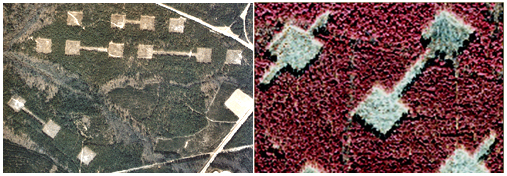Return on investment in habitat corridors

Aerial views of the square natural areas targeted in the study, and the linear habitat corridors established between them.
Habitat corridors are planted or wild strips of land between natural areas that encourage wildlife to migrate from place to place and, in turn, to help fertilize a broader range of places through the seeds they carry on them or digest. A recent study published in the Proceedings of the National Academy of Sciences has found that the establishment of habitat corridors between existing natural areas–and the resulting migration of wildlife between those areas–can increase biodiversity not only in connected sites, but also in habitat adjacent to those sites. In the study, conducted in South Carolina in conjunction with the USDA, the biodiversity spillover effect was found to extend beyond the boundaries of the connected natural areas by as much as 30%, resulting in a 10-18% increase in plant life–particularly native plants–in the larger area. The findings suggest that investments in habitat connections can pay off on a scale even beyond their designed ambition.
The master plan for Freshkills Park includes the establishment of habitat corridors around the bases of each of the site’s four landfill mounds, connecting to three large adjacent natural areas–the William T. Davis Wildlife Refuge, the Staten Island Greenbelt and Arden Heights Woods–as well as expanding biodiversity in the Freshkills Park site, itself, and in the general vicinity.
(via Scientific American)




